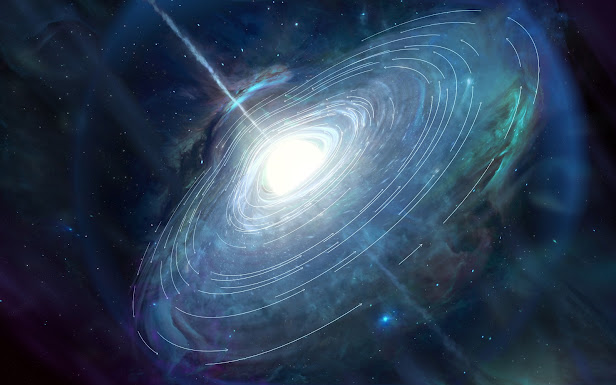WHAT IS A QUASAR?
The word quasar stands for quasi-stellar radio source. Quasars got that name because they looked starlike when astronomers first began to notice them in the late 1950s and early 60s. But quasars aren’t stars. Scientists now know they are young galaxies, located at vast distances from us, with their numbers increasing towards the edge of the visible universe. How can they be so far away and yet still visible? The answer is that quasars are extremely bright, up to 1,000 times brighter than our Milky Way galaxy. We know, therefore, that they’re highly active, emitting staggering amounts of radiation across the entire electromagnetic spectrum.
Shining so brightly that they eclipse the ancient galaxies that contain them, quasars are distant objects powered by black holes a billion times as massive as our sun. These powerful dynamos have fascinated astronomers since their discovery half a century ago.
In the 1930s, Karl Jansky, a physicist with Bell Telephone Laboratories, discovered that the static interference on transatlantic phone lines was coming from the Milky Way. By the 1950s, astronomers were using radio telescopes to probe the heavens, and pairing their signals with visible examinations of the heavens.
Aha!
Black holes don't emit light. But gas in the neighbourhood of a giant black hole can glow blindingly bright. The result: a quasar — the bright core of a very distant galaxy.
Half-Eaten Buffets and Shape-Shifters
It could be that a quasar does not have to clear its plate completely in order to shut down. One way to understand this is to break up the accretion disk into separate parts: a bright inner region that illuminates an outer dull region. Then if the black hole consumes the inner region (a process that could occur in mere months), the inner disk will disappear, and without its bright beacon, the outer disk will grow dark — much like the death of the sun would cause the moon to lose its shine.
Or it could be that the accretion disk changes its shape. It sounds wild, but this year studies of two different quasars found evidence to support this theory based on another echo. In each, the ultraviolet and blue colors fell away first, followed by the green and finally the red. That sequence flows from highest-energy colors to lowest-energy colors. It therefore resembles changes that ripple from the inner disk to the outer disk. “Something is causing the accretion disk to dim from the inside-out,” said Barry McKernan, an astrophysicist at the American Museum of Natural History.
A Murder-Suicide Pact
A quasar’s extreme wind drives dust and gas outside of the galaxy. Its extreme luminosity heats any leftover gas to such high temperatures that new stars can’t form. It effectively starves both itself and its host galaxy of the stars required to stay alive in “a murder-suicide pact".
In roughly five billion years, after all, our galaxy and the Andromeda galaxy will collide — likely sparking yet another quasar and throwing our night sky into disarray. But a clearer foresight into those details could come from better understanding this mysterious disappearing act.




Awesome info!
ReplyDeleteThank You!
Delete